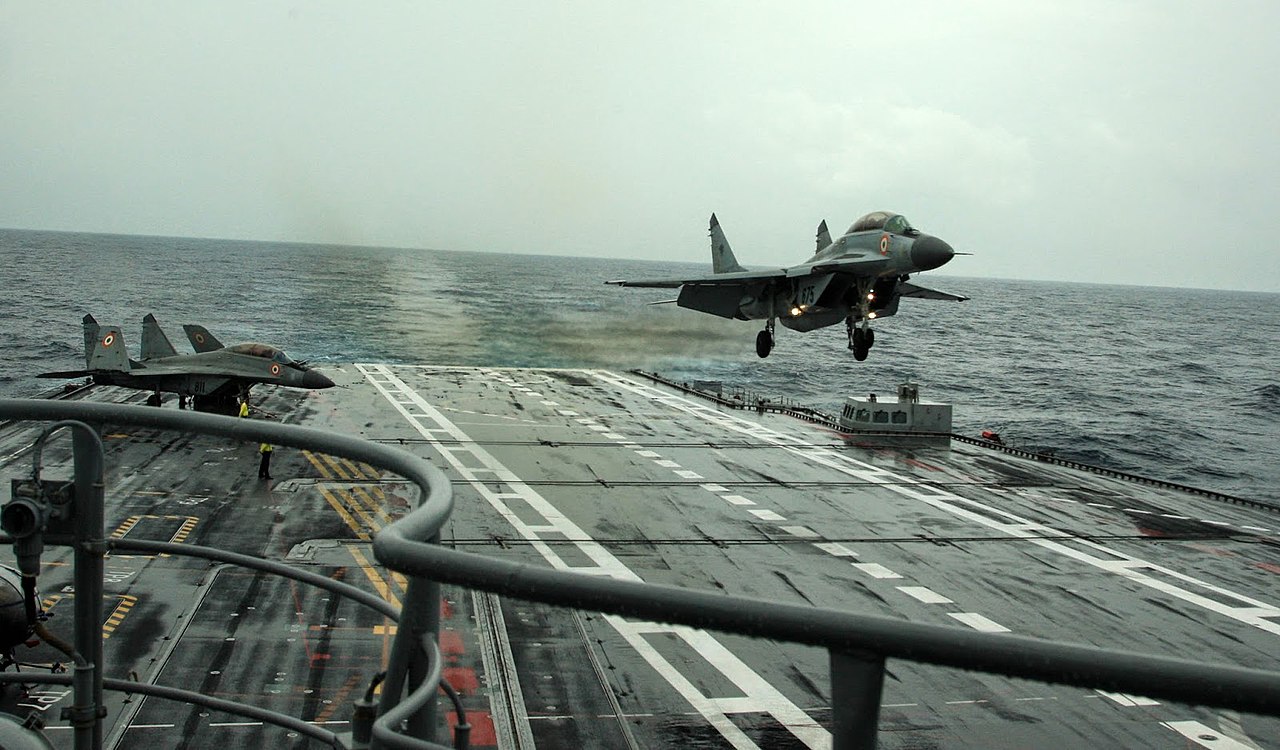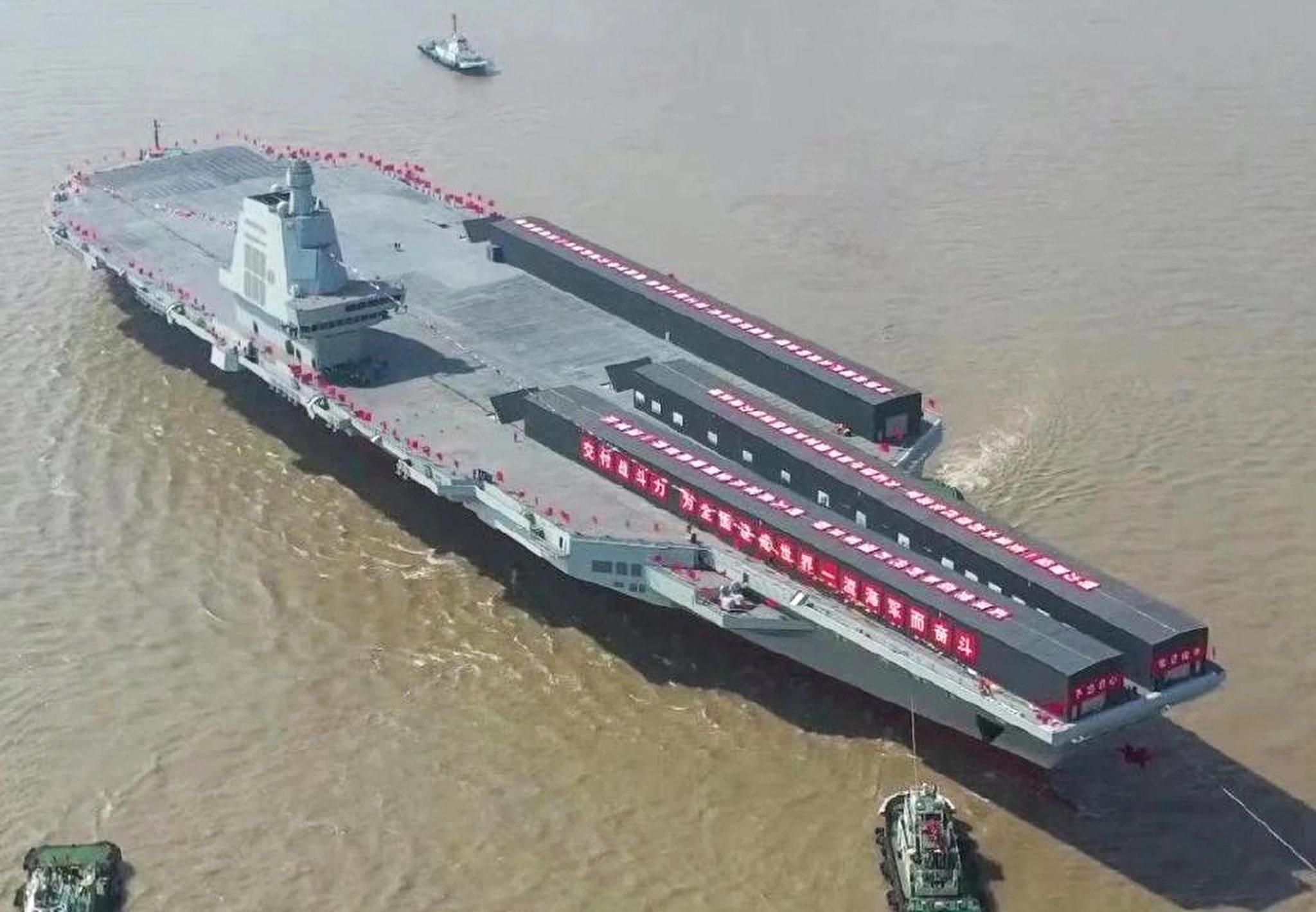Amidst the vast expanse of the world’s oceans, a high-stakes game of maritime dominance is unfolding. India and China are emerging as formidable contenders vying for the coveted crown in carrier supremacy.

As the tides of geopolitical power shift, these two titans of the Indo-Pacific region are leaving no stone unturned in their quest to project unparalleled naval might. While China’s third aircraft carrier embarks on its inaugural voyage, India is gearing up to initiate the construction of its third carrier.
In a bold move that underscores India’s ambitions to assert its naval prowess, the nation is gearing up to commence the construction of its third aircraft carrier.
Defence Minister Rajnath Singh’s recent remarks have ignited discussions about India’s aspirations to keep pace with its regional rival, China, in the high-stakes game of maritime dominance.
India’s current naval arsenal boasts two formidable aircraft carriers: the Russian-built INS Vikramaditya and the indigenously constructed INS Vikrant.
However, the country’s thirst for naval supremacy remains unquenched, prompting the defense ministry to contemplate building a second indigenous aircraft carrier, tentatively dubbed IAC-2 or INS Vishal, with a displacement of 65,000 tons.
Estimated to carry a staggering price tag of approx. $6.25 billion (INR 50,000 crore), the proposed warship, INS Vishal, is set to be constructed by the Cochin Shipyard.

The Indian Navy is optimistic about inducting this colossal vessel into its fleet by 2030, further bolstering its combat capabilities.
India’s journey towards self-sufficiency in aircraft carrier construction has been an arduous one.
The nation’s first indigenous aircraft carrier, INS Vikrant, took a staggering 23 years to complete, from the inception of its design in 1999 to its commissioning in September 2022.
Given this precedent, the construction of India’s second indigenous carrier is anticipated to span an additional 5 to 10 years.
As China continues to assert its maritime dominance through an aggressive shipbuilding program, India’s pursuit of a third aircraft carrier could be a strategic countermove, signaling its resolve to maintain a delicate balance of power in the region.
China’s Third Aircraft Carrier – The Fujian
Across the contested waters, China’s naval dominance takes another stride as the Fujian, the nation’s third aircraft carrier, recently concluded its sea trials.
Weighing a formidable 80,000 metric tonnes, this Type 003 class behemoth represents a significant technological leap forward compared to its predecessors within the People’s Liberation Army Navy (PLAN).
Only overshadowed in size by the US Navy’s Nimitz class (87,000 metric tonnes) and Gerald R. Ford class (100,000 metric tonnes) carriers, the Fujian stands as a testament to China’s growing maritime capabilities.
Dwarfing its predecessors, the Liaoning and Shandong, with their 60,000-tonne class, the Fujian boasts several catapults, replacing the ski jump ramp, facilitating the operation of a more extensive and potent fleet of shipborne aircraft.
Constructed at the Jiangnan Shipyard on Changxing Island near Shanghai, this engineering marvel signifies China’s self-reliance in shipbuilding and aviation technology.
In the vast expanse of the world’s oceans, a mere 13 navies command the formidable presence of 42 active aircraft carriers. However, only limited nations possess the coveted capability to construct these maritime giants: the United States, the United Kingdom, Russia, France, and the emerging duo of China and India.
As the Fujian prepares for action, China’s carrier fleet is poised to become the second-largest in the world, eclipsed only by the United States’ staggering eleven active carriers.
This feat is particularly remarkable considering China’s relatively recent foray into aircraft carrier operations. Its first such vessel, the Liaoning, was commissioned in 2012, a mere decade ago.
 File Image: Fujian during sea trials
File Image: Fujian during sea trials
In contrast, India boasts a more seasoned heritage, having commissioned its first aircraft carrier, the INS Vikrant (acquired from the British Royal Navy), as early as 1961.
Despite this historical advantage, China has swiftly closed the gap, propelled by burgeoning shipbuilding and aviation sectors that have shed their reliance on foreign technology.
As the tides of strategic calculations ebb and flow, whispers of China’s audacious ambitions to construct a fleet of at least six, and perhaps even eight, aircraft carriers have reverberated through the corridors of power.
This revelation, emanating from the esteemed S. Rajaratnam School of International Studies in Singapore, has sent shockwaves through the international community, underscoring the Dragon’s insatiable appetite for maritime dominance.
The Role of Aircraft Carriers
Talking about Aircraft carriers importance, “Aircraft carriers are not merely defensive platforms; they are offensive powerhouses with almost global reach providing strategic deterrence through their capability to dominate & intervene in even the distant-most theaters of war, trouble-spots or enemy locations, far far away from one’s own sea-shores.
An aircraft-centered flotilla is as if ‘moving one’s country’s armed-fist to any part of the world’.
It works as a floating & moving airfield with several war-planes on board that can launch these aircrafts to destroy enemy installations & forces in the interior hinterland of the enemy country” said Commander Dr. Bhushan Dewan, a former Indian Navy officer and veteran of the 1971 war.
“With their on-board aircrafts, diverse weaponry and accompanying flotilla of destroyers, frigates, and aircraft, they project force to distant locations, carrying the war at the enemy’s doorstep, as if, ‘nipping the trouble in its bud’, or ‘bearding the lion in his own den’.
In any significant & prolonged war at a distant location, a few destroyers or frigates without an aircraft carrier with its war-planes on board cannot assure victory.
Without such Naval assets as aircraft carriers, it’s impossible for the Navy to exercise assured control over one’s SLOCs: Sea Lines of Communication essential for ensuring uninterrupted flow of one’s global imports and exports through sea-trade” emphasized Dewan.
Drawing from his firsthand experience during the 1971 conflict, Dewan recollected, “The Sea Hawk attack aircrafts on board INS Vikrant successfully attacked many coastal towns in East Pakistan including Chittagong and Cox’s Bazar.
The continuous attacks later destroyed the Pakistan Air Force’s capability to retaliate.”
“If the Navy is to ensure its dominance in any distant theatre of war, and carry the attack to enemy’s doorstep, as well as safeguard sea lanes so as to ensure uninterrupted sea-trade, aircraft carriers are an indispensable part of an effective blue-water Naval force for protecting India’s defense & economic interests globally,” he concluded.
India’s Need For Third Aircraft
In the grand chess game of maritime supremacy, India finds itself at a pivotal crossroads, grappling with the critical need for a formidable third aircraft carrier. This strategic imperative is driven by a multitude of factors, each more compelling than the last.
Defense experts paint a vivid picture of the operational realities faced by India’s naval forces. At any given moment, nearly one-third of the fleet is embroiled in the intricate web of maintenance and repair, a necessary evil to ensure battle readiness.
However, to maintain an unwavering presence on both the eastern and western seaboard, a minimum of three aircraft carriers is an inescapable necessity.
This clarion call for a third flattop has reverberated through the corridors of power, with a parliamentary standing committee on defense echoing the sentiment.
In their resounding recommendation, they deemed three aircraft carriers an “unavoidable requirement” for the Indian Navy to bolster its combat capabilities, a stark assessment that cannot be ignored.
In the midst of this high-stakes contest, India’s imperative for a robust carrier fleet extends far beyond mere military posturing.
With a sprawling 7,000-kilometer coastline straddling both the eastern and western fronts, the nation’s territorial waters demand an unwavering maritime presence.
The Indian Ocean Region (IOR), a vital strategic expanse connecting West Asia to Southeast and East Asia, as well as Europe and the Americas, has become a crucible of global power projection, where major powers jostle for influence and securing vital interests.
To safeguard its sovereignty and seize maritime opportunities, India must gain dominance in this pivotal region, a feat that can only be achieved by projecting naval power.
From securing vital choke points to protecting trade routes and population centers, a formidable carrier strike group is an indispensable asset in India’s quest for regional preeminence.
Conclusion
Towering above the waves, an aircraft carrier is not merely a vessel; it is a meticulously engineered floating metropolis, a city at sea that defies the limits of conventional naval architecture.
The significance of this endeavor cannot be overstated, as India’s pursuit of a third aircraft carrier represents not just a logistical endeavor but a strategic gambit of monumental proportions.
With India and China vying to bolster their carrier fleets, the stage is set for a competitive race between these two Asian powerhouses. Therefore, India’s quest for a third aircraft carrier emerges as a meticulously calculated strategic maneuver.





